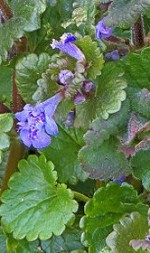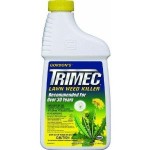 Also known as creeping Charlie, ground ivy is native of Europe and Asia that was brought to North America by early settlers for its medicinal and culinary value. It has become a weed, however, all over the United States except in the Rocky Mountains. It thrives in shady moist sites but can be found in full sun and dry soil. It is especially troublesome in lawns.
Also known as creeping Charlie, ground ivy is native of Europe and Asia that was brought to North America by early settlers for its medicinal and culinary value. It has become a weed, however, all over the United States except in the Rocky Mountains. It thrives in shady moist sites but can be found in full sun and dry soil. It is especially troublesome in lawns.
 Description: Ground ivy is a prostrate perennial that may form dense mats in gardens as well as lawns. The leaves are about the size of a quarter, kidney-shaped, and resemble those of true geraniums. They are lobed, borne opposite each other on long petioles, and have a distinct order when crushed. Like other members of the mint family they have square stems. The stems lie on the ground and root at the nodes. Purple-blue flowers are borne in clusters of three from mid-spring to early summer. The primary mode of reproduction is by creeping stems rather than by seed.
Description: Ground ivy is a prostrate perennial that may form dense mats in gardens as well as lawns. The leaves are about the size of a quarter, kidney-shaped, and resemble those of true geraniums. They are lobed, borne opposite each other on long petioles, and have a distinct order when crushed. Like other members of the mint family they have square stems. The stems lie on the ground and root at the nodes. Purple-blue flowers are borne in clusters of three from mid-spring to early summer. The primary mode of reproduction is by creeping stems rather than by seed.

 Control: Ground ivy can usually be hand pulled or hoed when present in the flower or vegetable garden but care must be taken to remove all of the creeping stems or the plant will reappear. Unfortunately ground ivy is more difficult to control in lawns. Maintaining a thick grown of grass and controlling light and moisture are helpful but not always practical. There are no preemergent herbicides that are effective but several applications of a postemergent herbicides containing dicamba such as Acme Trimec should bring positive results.
Control: Ground ivy can usually be hand pulled or hoed when present in the flower or vegetable garden but care must be taken to remove all of the creeping stems or the plant will reappear. Unfortunately ground ivy is more difficult to control in lawns. Maintaining a thick grown of grass and controlling light and moisture are helpful but not always practical. There are no preemergent herbicides that are effective but several applications of a postemergent herbicides containing dicamba such as Acme Trimec should bring positive results.
 To buy P. B. I./Gordon 791600 Trimec Lawn Weed Killer from Amazon.com click here.
To buy P. B. I./Gordon 791600 Trimec Lawn Weed Killer from Amazon.com click here.